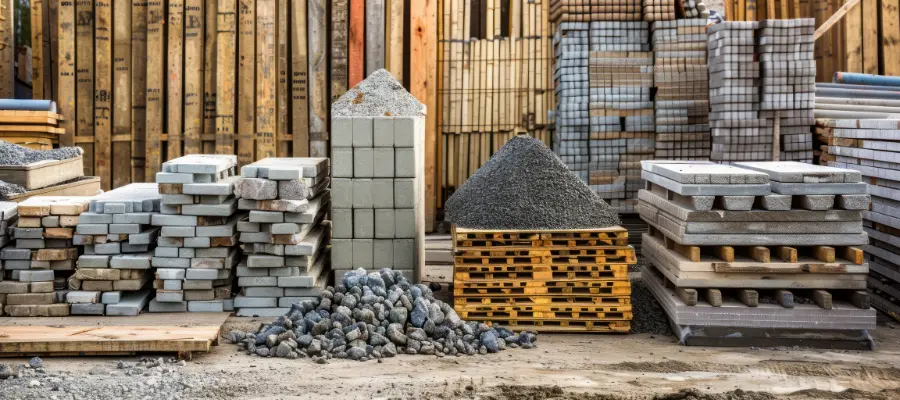Whenever you are going to build your dream house, material selection is crucial. There will be several properties to consider before the selection of building materials. One of them is the building material density. Density refers to how much mass is comprised within a given volume of a substance. It plays a key role in determining factors such as structural integrity, weight distribution, insulation properties, and cost-effectiveness.
In today’s blog of Brick & Bolt, you’ll understand the concept of building material density and why this property is so important in the construction industry.
What is Building Material Density?
The building material density or unit weight of any construction material is defined as the mass per unit volume of materials. Density indicates the degree of compactness of the material. It differs with temperature and pressure.
It is represented by a symbol ρ (rho). The density’s SI unit is kg/m³
The formula for density is,
Density = Mass/ Unit Volume
ρ = m/v
Common Building Materials and Their Densities in Room Temperature
Any substance used in building a structure is called construction building material. There are numerous materials used for building purposes. Some of the most common construction materials are discussed below.
1. Concrete
Concrete is the most utilised material in the construction process. There are various types of concrete used in construction and its density depends on the components with which it has been made, such as sand, water, types of cement, gravel, and limestone.
The density of concrete will be around 2400kg/m³.
2. Bricks
A brick is a construction material used to construct walls, pavements, and other elements of masonry construction. Brick density is an important parameter. It indicates the weight of the brickwork. Cores, Cells, and Frogs decrease the density, which in turn decreases the material cost. Different types of bricks have different densities. While fire clay bricks have a density of 2400 kg/m³, for common red bricks it is 1900 kg/m³.
3. Cement
Cement is a very useful binding material in construction. By altering the amount of an ingredient during cement production, one can achieve the desired cement quality. They are made of Lime, Silica, Alumina, Magnesia, Iron oxide, Calcium, Sulfur trioxide, and Alkaline.
Generally, the density of cement is 1440 kg/m³.
4. Sand

Sand is a mixture of small grains of rock and granular materials, and it is mainly defined by size: it is finer than gravel and coarser than silt.
The density of dry loose sand is 1442 kg/m³.
Dry sand’s density is 1602 kg/m³.
The density of packed sand is 1682 kg/m³.
5. Wood
Wood is one of the best sustainable construction materials, it is a natural resource from trees used in home construction. The basic wood density is the ratio of dry weight and volume of the given wood. More wood content in a specific volume means it has a high building material density. Wood density differs from type to type depending on the tree growth environment, species, and area measured for density calculation. Generally, it varies from 350-800 kg/m³.
6. Glass
The density of glass is an important factor in construction because it influences the weight and structural load of the building components where glass is used, such as windows, facades, and partitions.
The density of glass is 2500 kg/m³.
Following are some important building material densities.
| Building Material | Unit Weight/ Density(kg/m3) |
| Water | 1000 |
| AAC blocks | 550-850 |
| Bricks and Masonry Units | 1900 – 2100 |
| Cement | 1440 |
| Concrete | 2400 |
| Steel | 7700 |
| A.C Sheet | 17 Kg/m3 |
| Cast iron | 7203 |
| Wood | 350-800 |
| Aluminium | 2723 |
| Bitumen | 1019 – 1427 |
| Glass | 2580 |
Importance of Building Material Density

The density of building materials plays a crucial role in various aspects of construction:
- It affects the overall weight of a structure, influencing the design of home foundations, load-bearing components, and overall structural stability.
- Heavier, denser materials need stronger equipment and careful handling during transport and installation, which can affect project costs and logistics.
- Lighter building insulation materials offer better thermal resistance, helping improve a building’s energy efficiency by reducing heat transfer.
- The density of materials also plays a role in how well they absorb or reflect sound, which impacts the acoustics inside a building.
- For marine structures or buildings in flood-prone areas, the building material density relative to water is crucial for determining buoyancy and flotation.
- Denser materials often cost more per unit volume, so balancing density, strength, and cost is essential for optimising material usage and staying within budget.
Selecting Building Materials Based on Density
When selecting building materials, you should consider building material density along with other important factors such as strength, durability, cost, sustainability, and application-specific requirements. A higher-density material may sometimes be preferred for its structural strength or weight-bearing capacity. In other situations, a lower-density material might be more suitable for insulation or weight reduction purposes.
Concrete’s relatively high density offers excellent compressive strength and durability, making it suitable for structural elements like foundations and load-bearing walls. On the other hand, low-density insulation materials are preferred for their thermal resistance and energy efficiency benefits despite having lower structural strength.
Conclusion
The use of different materials in construction improves and strengthens the project. Building materials are also evolving along with the construction industry. Construction planners need to evaluate their building material options during the project planning phase to determine which materials will work best.
Before choosing building materials, it’s important to select based on the building material’s density, consult relevant building codes, industry standards, and regulations, and seek guidance from professionals like architects, engineers, and contractors. They can give valuable insights and recommendations based on the specific project requirements, local climate conditions, and other factors.

